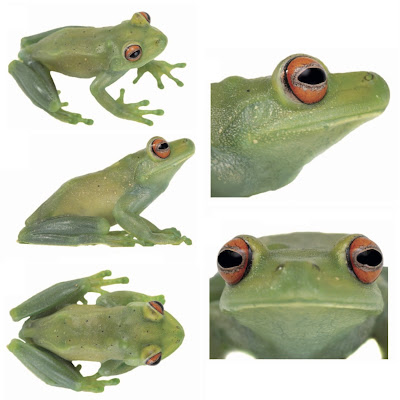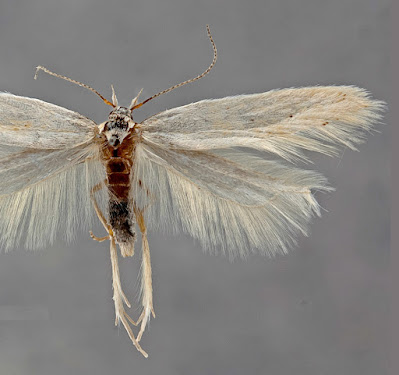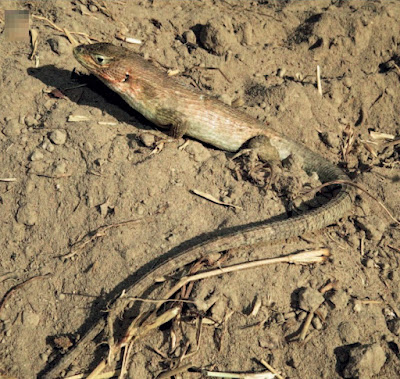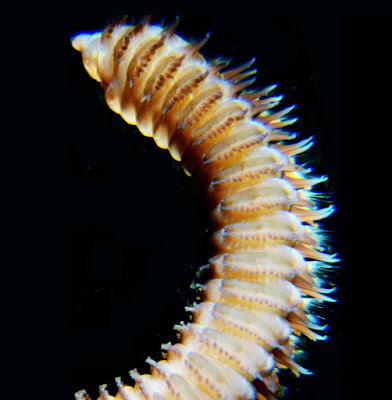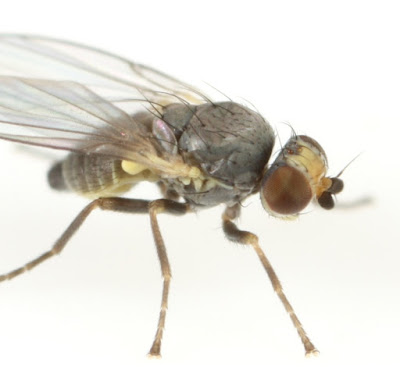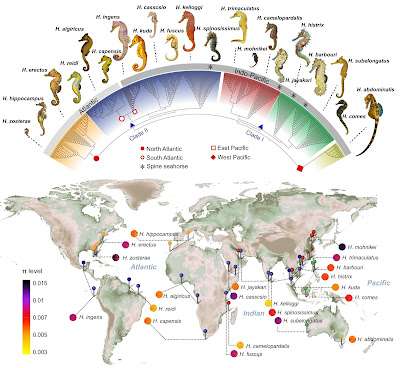[Most Recent Entries] [Calendar View]
Thursday, February 18th, 2021
| Time | Event | ||||||
| 1:55a | [Herpetology • 2021] Aplastodiscus heterophonicus • A New Cryptic Species of the Aplastodiscus albosignatus Group (Anura: Hylidae)
Abstract The genus Aplastodiscus currently includes 15 valid species, and a further five candidate species have already been pointed out in the literature. We here describe one of these candidate species, assigned to the A. albosignatus group, from the southeastern slopes of the Espinhaço Range, State of Minas Gerais, Brazil. The new species is cryptic with A. cavicola, being morphologically similar in both adult and larval stages. However, the two species are not sister taxa. The advertisement call of the new species is markedly distinct from all other known species of its genus. Examination of topotypic samples of A. cavicola corroborates the presence of this species in the Espinhaço Range, but also indicates the need for a revision of the taxonomic status of populations from the state of Rio de Janeiro assigned to this taxon. Key words. Amphibia, Anura, bioacoustics, conservation status, Neotropics, phylogeny, tadpoles, taxonomy, systematics. Aplastodiscus heterophonicus sp. n. Diagnosis: A green treefrog species of the genus Aplastodiscus characterized by adults with (1) small size (SVL 26.9–33.6 mm in males; 28.3–33.6 mm in females); (2) a well-developed supracloacal crest (character “present, restricted to the supracloacal region” of Berneck et al. 2016); (3) presence of webbing between fingers and toes; (4) presence of lateral fimbriae on forearms and shanks; (5) absence of nuptial pad in males; (6) in life, iris red to orange with a dark grey to silvery ring around the pupil; (7) small fringe of guanophores on lower lip margin (same as “white submandibular dermal fold” of Berneck et al. 2016; Bezerra et al. 2020); (8) no sexual dimorphism in SVL. Advertisement call (9) composed of scratchy notes partially pulsed to pulsatile; (10) presence of ascending frequency modulation; (11) call duration 167–280 ms; (12) peak frequency between 661.3 and 947.5 Hz. (13) Tadpoles with LTRF 2(2)/4(1); (14) oral disc with single row of marginal papillae; (15) with an anterior gap; (16) absence of posterior gap; (17) presence of few submarginal papillae laterally in the oral disc; (18) absence of small flaps with labial teeth laterally in the oral disc; (19) absence of paired light spots in the posterior portion of the body; (20) presence of dark longitudinal stripes in the tail, one between dorsal and ventral myotomes of muscle, restricted to the proximal quarter of tail length, and an interrupted narrow brown line on the dorsal margin of the muscle; (21) tail homogeneously marbled along its length; (22) presence of translucent fins. Etymology: The specific epithet derives from the Greek words ἕτερος (“heteros”), which means different, and φωνή (“phoné”), which means sound (and, also, the voice or cry of animals). The radicals heter- and phon- are linked through the connecting vowel -o-, followed by the Greek suffix -ικός, latinized as -icus, to form an adjective. The resulting specific epithet, heterophonicus, means “the one with a different voice”, in allusion to the very distinct call of the new species of Aplastodiscus described here. Paulo D. P. Pinheiro, Tiago L. Pezzuti, Bianca v. M. Berneck, Mariana L. Lyra, Raphael C. L. Lima and Felipe S. F. Leite. 2021. A New Cryptic Species of the Aplastodiscus albosignatus Group (Anura: Hylidae). SALAMANDRA. 57(1); 27-43. | ||||||
| 1:59a | [Entomology • 2021] Megacraspedus laseni • A New Species (Lepidoptera: Gelechiidae) from the Dolomites of north-eastern Italy
Abstract Megacraspedus laseni sp. nov. is described from Dolomiti Bellunesi (Veneto Region, Prov. Belluno, Italy). The habitus of the adult and male genitalia are described and illustrated whereas the female sex remains unknown. The new species belongs to the Megacraspedus pentheres species group and is closely related to the southern alpine M. eburnellus Huemer & Karsholt, 2001 from which it differs in morphological characters and in DNA barcode sequence. Megacraspedus carolustertius Gastón & Vives, 2020 is synonymized with M. quadristictus Lhomme, 1946, syn. nov. Keywords: Lepidoptera, Alps, Belluno, Anomologinae, morphology, DNA barcoding, new species, new synonymy Giovanni Timossi and Peter Huemer. 2021. Megacraspedus laseni sp. nov. (Lepidoptera: Gelechiidae) from the Dolomites of north-eastern Italy. Zootaxa. 4927(4); 559–566. DOI: 10.11646/zootaxa.4927.4.6 | ||||||
| 2:00a | [Herpetology • 2021] Stenocercus ica • A New Species of the Genus Stenocercus (Iguania: Tropiduridae) from the Peruvian Pacific Coast (Ica Region)
Abstract A new species of the genus Stenocercus is described from the Peruvian coastal desert in the Ica region. The new species is similar in ecology and morphology to Stenocercus modestus, but differs from it in lacking an oblique neck fold, a distinct patch of small scales posterior to the lateral region of the neck, and bright yellow lateral dots on the head and body in males. The new species also has more subdigital lamellae on the fourth toe than S. modestus, and females exhibit a wide dark stripe between the subocular and antehumeral regions, as well as dark reticulations in the gular region. Distribution models of the new species and S. modestus suggest no geographical overlap. In conclusion, morphology and species distribution models strongly imply the new Stenocercus species to be an undescribed lineage and different from all other species of the genus. This new species is the most southerly distributed Stenocercus in the Pacific coastal desert of Peru thus far. We propose the new species be classified as ‘Endangered’ based on its area of occupancy and threat-defined locations. Key words. Squamata, new species, coastal desert, distribution model, taxonomy.
Stenocercus ica sp. n. Diagnosis: (1) Maximum SVL in males 81.5 mm (N = 5); (2) maximum SVL in females 62.3 mm (N = 4); (3) vertebrals 44–48 (N = 11); (4) paravertebrals 44–48 (N = 11); (5) scales around midbody 35–38 (N = 11); (6) supraoculars 5–6 (N = 11); (7) internasals 2–4 (N = 11); (8) postrostrals 2–5 (N = 11); (9) loreals 1–3 (N = 11); (10) gulars 15–19 (N = 11); (11) lamellae on Finger IV 20–23 (N = 11); (12) lamellae on Toe IV 28–32 (N = 11); (13) posthumeral mite pockets absent (Type I of Torres-Carvajal 2007b); (14) postfemoral mite pockets present (Type II de Torres-Carvajal 2007b); (15) parietal eye visible; (16) smooth, juxtaposed, or slightly imbricate occipital scales; (17) projecting angular temporals absent; (18) enlarged supraoculars occupying most of the supraocular region in one row absent; (19) scales in the frontonasal region smooth, weakly imbricate anteriorly or juxtaposed (20) preauricular fringe present; (21) antehumeral and longitudinal folds present; (22) lateral nuchals similar in size to dorsal nuchals; (23) posterior gulars smooth, cycloid, imbricate , with or without notches or apical pits; (24) a caudad notch on ventral scales; (25) lateral body scales similar in size to dorsal scales; (26) vertebrals similar in size to adjacent dorsals; (27) dorsolateral crests absent; (28) ventrals smooth, imbricate, sub-rhomboidal, similar in size to dorsals; (29) scales on the posterior faces of thighs granular; (30) prefemoral fold absent; (31) inguinal groove absent; (32) preanals not projected; (33) tail slightly compressed laterally in adult males; (34) tail length 70–73% of total length; (35) three caudal whorls per autotomic segment; (36) caudals not spinose; (37) dark stripe from the subocular region to superciliars absent; (38) colour pattern of dark reticulations in the gular region in adult females; (39) dark streaks that form a reticulum in the gular region in adult males absent; (40) black spot on ventral face of neck in adult males absent; (41) dark midventral stripe in adult males absent; (42) black patches on ventral faces of thighs in adult males absent; (43) background colour of dorsum olive yellowish to brown in life. Etymology. The specific epithet ica is a noun in apposition and refers to the Ica region of Peru where all type specimens were collected. It also refers to Ica as being the southernmost distribution record for the genus on the Peruvian Pacific coast. Distribution: Stenocercus ica sp. n. is as yet only known from the valley of the Ica river basin, with the highest number of individuals recorded at two localities (Arrabales and Ocucaje) in the Ica region between 300 to 450 m a.s.l. on the Peruvian Pacific coast. Stenocercus ica sp. n. appears to be restricted to low altitudes (Figs 6–7). Natural history: Stenocercus ica sp. n. has been found in dense shrub vegetation close to riverside forest and the irrigation installations in agricultural areas in the Ica river basin (Fig. 5A). Specimens were observed basking at the edge of a bushy area, mainly on dry leaf litter, fallen branches, and on the, usually in dappled or diffused sunlight. Two specimens were observed escaping into holes at the base of bushes, under accumulations of leaf litter. This species probably utilizes these cavities as burrows and nests. Alejandro Mendoza, César Ramírez, Diego Barrera and César Aguilar-Puntriano. 2021. A New Species of the Genus Stenocercus (Iguania: Tropiduridae) from the Peruvian Pacific Coast (Ica Region). SALAMANDRA. 57(1); 1-14. Resumen. Se describe una nueva especie del género Stenocercus del desierto costero peruano en el Departamento de Ica. La nueva especie es similar en ecología y morfología a Stenocercus modestus, pero difiere al carecer de un pliegue oblicuo en el cuello, un parche visible de pequeñas escamas posteriores a la región lateral del cuello y puntos amarillos brillantes sobre la cabeza y el cuerpo en los machos. La nueva especie también tiene un mayor número de lamelas subdigitales en el cuarto dedo de la pata posterior que S. modestus, y las hembras muestran una ancha franja oscura entre la región subocular y antehumeral, así como reticulaciones oscuras en la región gular. Los modelos de distribución de la nueva especie y S. modestus no muestran superposición en sus distribuciones potenciales. En conclusión, la morfología y los modelos de distribución de especies sugieren fuertemente que la nueva especie de Stenocercus es un linaje no descrito y diferente de otras especies del género. La nueva especie es el registro más sureño de su género en el desierto costero del pacifico en Perú. Así mismo, recomendamos que se clasifique como En peligro basado en el área de ocupación y localidades con amenazas. Palabras clave. Squamata, desierto costero, modelo de distribución, taxonomía. | ||||||
| 7:45a | [Invertebrate • 2021] New Species and Records of Orbiniidae (Annelida, Polychaeta) from Continental Shelf and Slope Depths of the Western North Atlantic Ocean
Abstract Twenty-four species of Orbiniidae, 12 new to science, are reported from continental shelf and slope (deep-sea) habitats of the western North Atlantic. The majority of new material was collected during reconnaissance and monitoring surveys along the entire U.S. Atlantic coast from New England to the Carolinas that were intended to understand the potential impacts of oil and gas exploration in poorly known offshore environments. Additional materials from shallow water and shelf habitats off New England and New York as part of other projects are also included. New collections of Califia schmitti (Pettibone, 1957), Leitoscoloplos acutus (Verrill, 1873), L. fragilis (Verrill, 1873), L. obovatus Mackie, 1987, L. robustus (Verrill, 1873), Scoloplos intermedius (Hartman, 1965), Orbinia swani (Pettibone, 1957), Phylo felix (Kinberg, 1866), P. norvegicus (Sars, 1872), P. ornatus (Verrill, 1873), and Questa trifurcata (Hobson, 1970) provide additional morphological details, variability, and extended geographic and bathymetric distributions of previously known species. New species include Leitoscoloplos pustulus n. sp., Scoloplos papillatus n. sp., S. pettiboneae n. sp., S. pseudoarmiger n. sp., S. verrilli n. sp., Leodamas cuneatus n. sp., L. mucronatus n. sp., L. notoaciculatus n. sp., Phylo paraornatus n. sp., Orbiniella acsara n. sp., O. armata n. sp., and O. mimica n. sp. Juveniles of some species of Leitoscoloplos and Scoloplos were found to resemble known species of the meiofaunal orbiniid genus Schroederella Laubier, 1962. As such, S. berkeleyi Laubier, 1971 is referred to synonymy with Leitoscoloplos acutus. More importantly, the genus Schroederella was found to be pre-occupied by Schroederella Enderlein, 1921 in the Insecta, Diptera, family Helomyzidae. Gesaschroederella nomen nov. is therefore proposed as a replacement name for the polychaete homonym. Keywords: Annelida, New England, North Carolina, South Carolina, deep-sea, Califia, Leodamas, Leitoscoloplos, Orbinia, Orbiniella, Phylo, Questa, Schroederella, Scoloplos Phylo ornatus (Verrill, 1873) James A. Blake. 2021. New Species and Records of Orbiniidae (Annelida, Polychaeta) from Continental Shelf and Slope Depths of the Western North Atlantic Ocean. Zootaxa. 4930(1); 1-123. DOI: 10.11646/zootaxa.4930.1.1 | ||||||
| 8:03a | [Entomology • 2021] Thirteen New Species of Agromyzidae (Diptera) from the United States, with New Host and Distribution Records for 32 Additional Species
Abstract We present novel rearing records of Agromyzidae (Diptera) from throughout the United States. We describe leaf mines or other larval habits for 27 species, plus five others whose identification is tentative, and another five that are identified only to genus due to the absence of male specimens. We review host and distribution data for the known species, reporting 26 new host species records (including the first rearing records for Phytomyza flexuosa Spencer, P. notopleuralis Spencer, and (tentatively identified) Ophiomyia frosti Spencer) and 25 new state records (including the first USA records for P. krygeri Hering, P. thermarum (Griffiths), and (tentatively identified) Liriomyza cracentis Lonsdale). We also describe and provide natural history information for the following 13 new species: Haplopeodes loprestii Eiseman & Lonsdale, Liriomyza euphorbivora Eiseman & Lonsdale, L. hypopolymnia Eiseman & Lonsdale, Melanagromyza arnoglossi Eiseman & Lonsdale, M. gentianivora Eiseman & Lonsdale, M. hieracii Eiseman & Lonsdale, M. rudbeckiae Eiseman & Lonsdale, M. urticae Eiseman & Lonsdale, M. verbenivora Eiseman & Lonsdale, Ophiomyia nabali Eiseman & Lonsdale, O. rugula Eiseman & Lonsdale, Phytomyza flavilonicera Eiseman & Lonsdale, and P. triostevena Eiseman & Lonsdale. Keywords: Diptera, leafminer, plant-insect interactions, rearing Charles S. Eiseman, Owen Lonsdale, John van der Linden, Tracy S. Feldman and Michael W. Palmer. 2021. Thirteen New Species of Agromyzidae (Diptera) from the United States, with New Host and Distribution Records for 32 Additional Species. Zootaxa. 4931(1); 1-68. DOI: 10.11646/zootaxa.4931.1.1 | ||||||
| 10:10a | [Ichthyology • 2021] Genome Sequences reveal Global Dispersal Routes and Suggest Convergent Genetic Adaptations in Seahorse Evolution
Abstract Seahorses have a circum-global distribution in tropical to temperate coastal waters. Yet, seahorses show many adaptations for a sedentary, cryptic lifestyle: they require specific habitats, such as seagrass, kelp or coral reefs, lack pelvic and caudal fins, and give birth to directly developed offspring without pronounced pelagic larval stage, rendering long-range dispersal by conventional means inefficient. Here we investigate seahorses’ worldwide dispersal and biogeographic patterns based on a de novo genome assembly of Hippocampus erectus as well as 358 re-sequenced genomes from 21 species. Seahorses evolved in the late Oligocene and subsequent circum-global colonization routes are identified and linked to changing dynamics in ocean currents and paleo-temporal seaway openings. Furthermore, the genetic basis of the recurring “bony spines” adaptive phenotype is linked to independent substitutions in a key developmental gene. Analyses thus suggest that rafting via ocean currents compensates for poor dispersal and rapid adaptation facilitates colonizing new habitats.
Chunyan Li, Melisa Olave, Yali Hou, Geng Qin, Ralf F. Schneider, Zexia Gao, Xiaolong Tu, Xin Wang, Furong Qi, Alexander Nater, Andreas F. Kautt, Shiming Wan, Yanhong Zhang, Yali Liu, Huixian Zhang, Bo Zhang, Hao Zhang, Meng Qu, Shuaishuai Liu, Zeyu Chen, Jia Zhong, He Zhang, Lingfeng Meng, Kai Wang, Jianping Yin, Liangmin Huang, Byrappa Venkatesh, Axel Meyer, Xuemei Lu and Qiang Lin. 2021. Genome Sequences reveal Global Dispersal Routes and Suggest Convergent Genetic Adaptations in Seahorse Evolution. Nature Communications. 12, 1094. DOI: 10.1038/s41467-021-21379-x |
| << Previous Day |
2021/02/18 [Calendar] |
Next Day >> |
